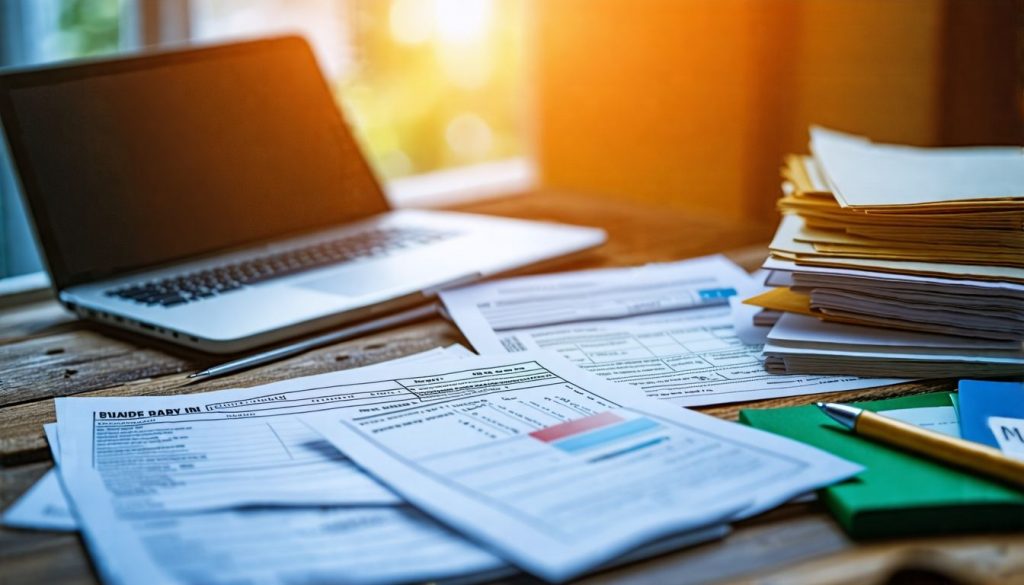Receiving a notice of collection from the CRA signals a serious issue with unpaid tax debts. This notice is a legal warning that demands immediate attention. Our blog will guide you through understanding the significance of receiving a notice of collection from the CRA, exploring your options for managing and resolving this stressful situation.
Keep reading to find out how to navigate this challenge.
Key Takeaways
- Getting a Notice of Collection from the CRA means you have unpaid taxes. It’s a warning that needs quick action to avoid worse problems like losing part of your income or having your bank account taken.
- You can make a plan to pay off your tax debts in parts, ask for less debt based on hardship, or get penalties removed if you act fast. Not dealing with it can lead to bigger debts and trouble getting loans.
- A Licensed Insolvency Trustee can guide you through paying back taxes and protect you legally. They help make a plan that works for you and talk to the CRA on your behalf to find the best solution.
- Ignoring notices from the CRA can cause them to take serious actions like taking money directly from people who owe you or freezing your accounts. Quick responses prevent extra fees and legal issues.
- Understanding how to stay right with tax laws helps keep future debts away. Learning this now stops more troubles later on.
What is a Notice of Collection from the CRA and Why Is It Important?
A Notice of Collection from the CRA informs you about unpaid taxes. It is a crucial step in the debt collection process that demands your attention.
Debt collection process at the CRA
The Canada Revenue Agency (CRA) has a specific debt collection process aimed at recovering outstanding tax debts. After an individual receives a notice of assessment or reassessment indicating amounts owed, the CRA issues a notice of collection as a legal warning for unpaid taxes.
This step is crucial; ignoring it can lead to serious consequences, including wage garnishment and bank account seizures. Should payment agreements fail, the CRA may issue a ‘Requirement to Pay’ (RTP) against individuals responsible for tax liabilities.
Taxpayers should understand that once the CRA issues this notification, they possess enhanced collection rights compared to ordinary creditors. The agency’s authority extends beyond just notifying taxpayers about their debts; it includes enforcing legal remedies without delay.
It’s essential for Canadians facing such notices to act promptly in order to avoid further financial turmoil and potential legal action regarding unpaid taxes.
Taking swift action on your tax debts can prevent larger financial issues down the line.
Notification of debt collection
A notice of debt collection from the CRA serves as a formal alert that you owe unpaid tax debts. This notification is crucial because it indicates that immediate payment is required to avoid serious consequences.
Once issued, the CRA can initiate wage garnishment or garnish bank accounts to recover what is owed. Ignoring this notice can lead to further legal action for unpaid taxes and additional penalties and interest on your debt.
Notably, if individuals have defaulted on their obligations regarding Canada Emergency Business Account (CEBA) loans, those amounts may also be collected through this process. Prompt attention to such notifications can help prevent escalation into more severe financial and legal repercussions.
Impact of ignoring the notice
Ignoring a notice of collection from the CRA can lead to serious financial and legal trouble. The CRA has significant powers that extend beyond those of ordinary creditors, including wage garnishment and bank account seizures.
Once they issue a notice, they can enforce their legal remedies swiftly. This means unpaid taxes may result in immediate action if no payment agreement is established.
Failing to address the issue promptly may lead to additional tax penalties and increased debt over time. Tax debts must be taken seriously as consequences escalate quickly if ignored, making it crucial for Canadians to understand their taxpayer rights and options for resolution with the CRA.
Solutions exist for managing tax debt effectively, ensuring compliance with taxation laws while minimizing further repercussions.
Understanding and Dealing with a Notice of Collection
A Notice of Collection means you owe taxes to the CRA. You can pay off your debt in several ways, but ignoring it can lead to serious problems.
Options for paying off tax debt
Receiving a notice of collection from the CRA means you have unpaid tax debts. Taking action quickly can help resolve this situation.
- Full Payment: If possible, pay the total amount owed right away. The notice of collection serves as a legal warning about your unpaid tax debts. Paying in full stops further legal actions by the CRA.
- Payment Plan: You can set up a payment plan with the CRA if you cannot pay everything at once. This option allows you to make smaller payments over time without facing immediate legal consequences.
- Tax Debt Reduction: In some cases, you may negotiate for a reduction in your tax debt. The CRA may accept less than what you owe if you demonstrate genuine financial hardship.
- Interest and Penalties Review: Check if any interest or penalties may be removed by contacting the CRA directly. They may waive certain fees if circumstances are severe enough.
- Seek Assistance from Professionals: A Licensed Insolvency Trustee can help manage your tax debt effectively. They provide advice tailored to your situation, ensuring that you understand available options for resolution.
- Requirement to Pay (RTP): If you’ve missed payment agreements, prepare for an RTP from the CRA targeting others who owe money to you. This might involve accessing bank accounts or wages, so it’s best to address any outstanding debts promptly.
Each of these options holds significant importance in managing unpaid tax notifications and avoiding serious consequences from the CRA’s debt collection process.
Consequences of not paying
Ignoring a Notice of Collection from the CRA can lead to serious consequences. The CRA has powerful collection rights and may escalate actions such as wage garnishment or bank account seizures.
Once a notice is issued, immediate legal remedies come into play, creating urgency in your financial situation. Failure to address tax debt may result in a ‘Requirement to Pay’ (RTP) being sent out to any person who owes you money, extending the impact beyond just you.
Unpaid debts can quickly accumulate additional interest and penalties under Canada’s tax laws. The ramifications could affect not only your current finances but also future credit opportunities.
Serious non-compliance with the CRA could influence various aspects of your life, including potential delays in important matters like loans or mortgages if they perceive financial irresponsibility due to unaddressed tax obligations.
How to seek assistance and manage the debt with a Licensed Insolvency Trustee
A Licensed Insolvency Trustee (LIT) can help you manage your tax debt effectively. They offer guidance and support during challenging financial times.
- Understanding Your Situation: An LIT will assess your financial situation. They take into account your income, expenses, and any debts you owe to the CRA. This understanding is crucial for creating a plan.
- Exploring Payment Options: The trustee will discuss various payment options with you. They can help set up a feasible repayment plan to address your tax debt notice from the CRA.
- Negotiating with the CRA: An LIT has experience dealing with the CRA’s collection process. They can negotiate on your behalf to find a reasonable resolution to your tax issues.
- Providing Legal Protection: Once you work with an LIT, they provide legal protection against CRA actions like wage garnishment or bank account seizures. This means you can focus on resolving your debt without the fear of immediate legal consequences.
- Creating a Debt Management Plan: The trustee will help develop a customized debt management plan based on your needs and circumstances. This plan may include alternatives such as filing for bankruptcy or making a consumer proposal.
- Offering Ongoing Support: Throughout the process, the LIT provides ongoing support and advice. They guide you in understanding what each step means for your financial future.
- Educating You on Tax Compliance: Your trustee will inform you about tax compliance moving forward to avoid similar situations in the future. Understanding these rules can prevent more tax debt from accumulating.
- Assessing Impact of Ignoring Notices: An LIT explains the potential consequences of ignoring notices from the CRA, which could lead to increased collection measures like Requirement to Pay (RTP). Taking action sooner rather than later can save money and stress in the long run.
- Addressing CEBA Loan Defaults: If you defaulted on a Canada Emergency Business Account (CEBA) loan, an LIT is qualified to assist you in addressing this issue through proper channels at the CRA.
- Facilitating Communication with Creditors: The trustee acts as a mediator between you and other creditors as well, providing clarity on all aspects of your financial obligations until everything is resolved successfully.
Conclusion
Receiving a Notice of Collection from the CRA is a serious matter that demands swift attention. Ignoring this notification can lead to significant financial and legal repercussions.
The CRA has robust collection powers that exceed those of typical creditors, making it crucial to act promptly. Addressing your tax debt proactively can prevent wage garnishments and bank account seizures.
Taking the necessary steps now will help you secure your financial future and avoid further complications.
FAQs
1. What does it mean to receive a Notice of Collection from the CRA?
Receiving a Notice of Collection from the CRA means you have tax debt, and they are initiating their debt collection process.
2. Can I stop legal action by the CRA after receiving a Notice of Collection?
Yes, understanding your tax debt resolution options can help stop CRA legal action. It’s best to seek professional advice promptly.
3. What happens if I ignore communication from the CRA about my tax debts?
Ignoring CRA communication might lead to serious consequences such as increased financial penalties or even an audit.
4. How can I resolve my issues with the CRA regarding tax collection?
You should respond immediately to any notices received, understand your rights and obligations, and explore all available resolution options for your tax collection issues.








